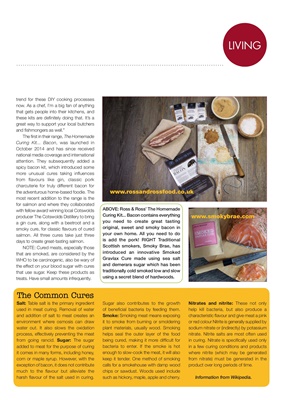
KITLIVING
trend for these DIY cooking processes
now. As a chef, I'm a big fan of anything
that gets people into their kitchens, and
these kits are definitely doing that. It's a
great way to support your local butchers
and fishmongers as well."
The first in their range, The Homemade
Curing Kit... Bacon, was launched in
October 2014 and has since received
national media coverage and international
attention. They subsequently added a
spicy bacon kit, which introduced some
more unusual cures taking influences
from flavours like gin, classic pork
charcuterie for truly different bacon for
the adventurous home-based foodie. The
most recent addition to the range is the
for salmon and where they collaborated
with fellow award winning local Cotswolds
producer The Cotswolds Distillery to bring
a gin cure, along with a beetroot and a
smoky cure, for classic flavours of cured
salmon. All three cures take just three
days to create great-tasting salmon.
NOTE: Cured meats, especially those
that are smoked, are considered by the
WHO to be carcinogenic, also be wary of
the effect on your blood sugar with cures
that use sugar. Keep these products as
treats. Have small amounts infrequently.
ABOVE: Ross & Ross' The Homemade
Curing Kit... Bacon contains everything
you need to create great tasting
original, sweet and smoky bacon in
your own home. All you need to do
is add the pork! RIGHT Traditional
Scottish smokers, Smoky Brae, has
introduced an innovative Smoked
Gravlax Cure made using sea salt
and demerara sugar which has been
traditionally cold smoked low and slow
using a secret blend of hardwoods.
www.rossandrossfood.co.uk
www.smokybrae.com
Sugar also contributes to the growth
of beneficial bacteria by feeding them.
Smoke: Smoking meat means exposing
it to smoke from burning or smoldering
plant materials, usually wood. Smoking
helps seal the outer layer of the food
being cured, making it more difficult for
bacteria to enter. If the smoke is hot
enough to slow-cook the meat, it will also
keep it tender. One method of smoking
calls for a smokehouse with damp wood
chips or sawdust. Woods used include
such as hickory, maple, apple and cherry.
Salt: Table salt is the primary ingredient
used in meat curing. Removal of water
and addition of salt to meat creates an
environment where osmosis can draw
water out. It also slows the oxidation
process, effectively preventing the meat
from going rancid. Sugar: The sugar
added to meat for the purpose of curing
it comes in many forms, including honey,
corn or maple syrup. However, with the
exception of bacon, it does not contribute
much to the flavour but alleviate the
harsh flavour of the salt used in curing.
Nitrates and nitrite: These not only
help kill bacteria, but also produce a
characteristic flavour and give meat a pink
or red colour Nitrite is generally supplied by
sodium nitrate or (indirectly) by potassium
nitrate. Nitrite salts are most often used
in curing. Nitrate is specifically used only
in a few curing conditions and products
where nitrite (which may be generated
from nitrate) must be generated in the
product over long periods of time.
Information from Wikipedia.
The Common Cures